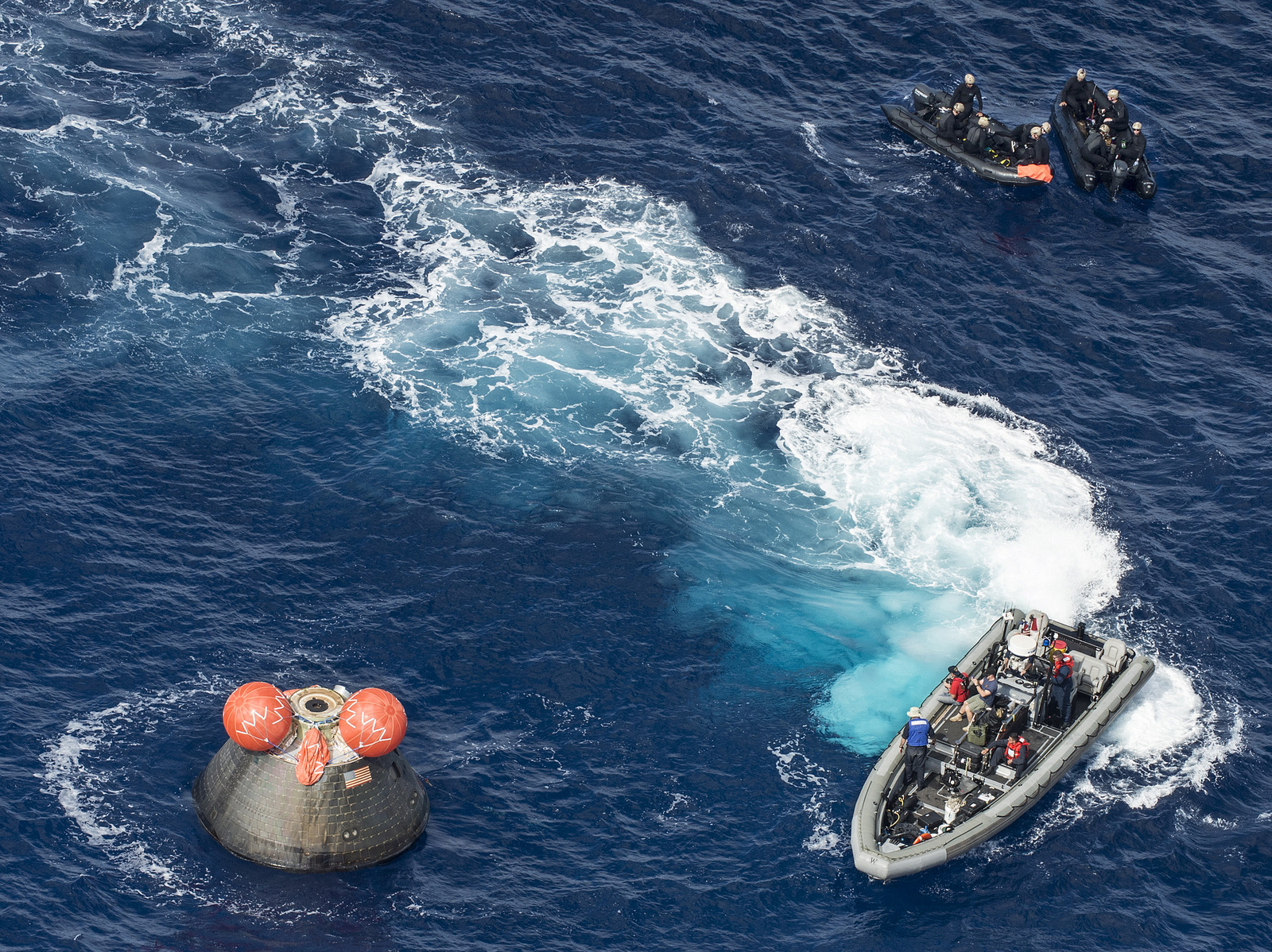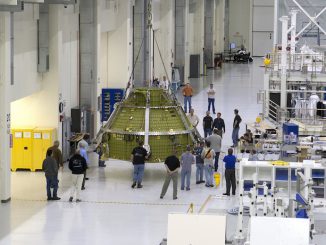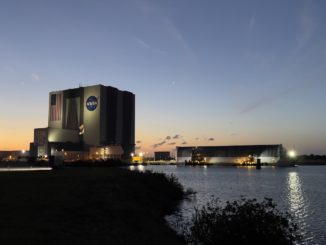
Engineers plan to redesign part of the Orion capsule’s self-righting flotation system that only partially engaged as the spacecraft splashed down in the Pacific Ocean following an orbital test flight in December, NASA officials said.
The airbag system was the only part of the Orion test flight that did not go according to plan, and NASA officials have hailed the mission as a success.
The airbags are designed to flip the Orion capsule upright if it lands upside down. The craft splashed down in the so-called “Stable 1” configuration — right side up — after its two-orbit test flight Dec. 5.
But the airbags are designed to inflate on every mission, and only two of the five spheres kept pressure as designed. Two more bags quickly lost pressure after inflation, and another failed to fill with helium at all, according to Jules Schneider, Lockheed Martin’s Orion operations manager at the Kennedy Space Center in Florida.
Lockheed Martin is prime contractor for the Orion program. The company managed the capsule’s Dec. 5 test flight.
The Orion spacecraft launched from Cape Canaveral aboard a Delta 4-Heavy rocket and reached a maximum altitude of 3,600 miles during the mission, which lasted four-and-a-half hours from takeoff to splashdown.
Lockheed Martin will deliver a post-mission report to NASA on March 4, and a first glance at the flight’s results show the Orion spacecraft met 85 of 87 test objectives outlined before the launch.
“The two we didn’t (meet) was to inflate all of the crew module uprighting system bags and keep them inflated for an extended period of time,” said Bill Hill, NASA’s deputy associate administrator for exploration systems development. “They’re supposed to be able to maintain inflation for 24 hours, and we did not meet that capability.”
Pyrotechnic initiators in the airbag system fired as designed, Hill said, but only two of the airbags pressurized and stayed inflated.
Hill told the NASA Advisory Council’s human exploration and operations committee Jan. 13 that engineers will have to change the design of the internal plumbing that feeds the airbag system.
“We’ve got some redesigning to do on that,” Hill said. “The plumbing, I don’t think anybody believes is a long-term capability. It’s a 5,000 psi (pounds per square inch) helium system, and we’re using threaded connections. We believe that we probably leaked out anything that was attempted to be inflated. We don’t know that yet for sure, but that’s one of the things we’re intending to investigate.”
NASA billed the Dec. 5 test flight — named Exploration Flight Test-1 — as an opportunity to wring out technical problems before a major engineering review planned this year to finalize the Orion spacecraft’s design.
Another unpiloted Orion test flight is scheduled for 2018 for liftoff on NASA’s new Space Launch System heavy-lift rocket. The first Orion mission with astronauts on-board is set for 2021 to the vicinity of the moon.
“EFT-1 was tremendously successful,” said Bill Gerstenmaier, head of NASA’s human exploration and operations directorate. “The data review so far looks really, really good.”

Gerstenmaier said the spacecraft used “dramatically less” hydrazine maneuvering fuel than predicted, and the capsule received better than expected navigation data from GPS satellites.
The Orion spacecraft consumed 93 pounds of hydrazine fuel during the test flight. The propellant fed thrusters that kept the capsule on track after separating from the Delta 4 rocket’s upper stage for re-entry.
Officials predicted the craft would burn about 119 pounds of hydrazine, according to a chart presented by Hill to the advisory committee.
“The biggest thing that we under-predicted on was the hydrazine consumption — the propellant for in-space maneuvers,” Hill said.
Hill credited an on-target launch from United Launch Alliance’s Delta 4 for the low fuel consumption.
“ULA placed us right where we asked them to place us,” Hill said. “We were actually over two sigma (two standard deviations) low on that prediction, and that’s something we will take a look at because we’ve got about 300 pounds of hydrazine to off-load the vehicle.”
The capsule also used less battery power than NASA expected, according to Hill.
After splashdown in the Pacific Ocean, U.S. Navy divers recovered the capsule and returned it to San Diego aboard the USS Anchorage amphibious transport ship. NASA trucked the spacecraft across the country to the Kennedy Space Center, where it arrived Dec. 18 for post-flight processing.
The capability to reuse the Orion capsule was not part of the test flight’s success criteria, but NASA plans to recycle the spacecraft to fly on an atmospheric high-altitude abort test in 2018.
“The spacecraft looks reusable, and it’s in fine shape,” Hill said, adding that a thorough engineering inspection is still needed to make a final determination whether the capsule can be used again.
“We’re still taking a look at where we might use it,” Hill said. “Our original plan was to use the EFT-1 command module for the altitude abort test, and we’re in the process of evaluating that.”
Ground teams noticed a few dings on the outer skin of the spacecraft, likely from strikes by space debris.
“All in all, it’s in great shape,” Hill said. “The backshell portion that we’re pulling off to de-service — those are the black portions on the upper part of the vehicle — they look like they could be reused.”
The capsule’s 16.5-foot-diameter heat shield worked well, officials said.
The Orion spacecraft plunged back into the atmosphere at 20,000 mph — about 84 percent of the velocity it would see coming back from the moon — and weathered temperatures near 4,000 degrees Fahrenheit.
Avcoat insulation manually applied to 330,000 individual cells on the heat shield’s fiberglass-phenolic honeycomb structure was supposed to ablate away during the Orion spacecraft’s re-entry, protecting the underlying structure from searing temperatures.
The Orion heat shield’s titanium skeleton and carbon fiber skin was fabricated by Lockheed Martin in Colorado. The skeleton was shipped to Textron Defense Systems in Massachusetts for installation of the honeycomb structure and filling of the Avcoat cells.
NASA and Lockheed Martin will likely change the heat shield design for future Orion missions, using the same material but a different manufacturing method.
Hill said engineers are evaluating a “block” heat shield design to replace the “monolithic” structure used on EFT-1.
“We had cracking issues with the monolithic (design), very similar to what Apollo dealt with,” Hill said. “We had a standard repair that they used, and we used, prior to launch. We’re trying to get away from that.”
Under the block design approach, Textron will apply the Avcoat to the heat shield differently. The heat shield for Orion’s Dec. 5 test flight was manufactured in one piece instead of in multiple blocks.
Hill said switching to a heat shield composed of multiple blocks would allow Textron to add the Avcoat ablator over time instead of all at once, ensuring workers retain “critical skills” needed for the Orion program.
A final decision on a new heat shield design is planned for April, Hill said.
Follow Stephen Clark on Twitter: @StephenClark1.



